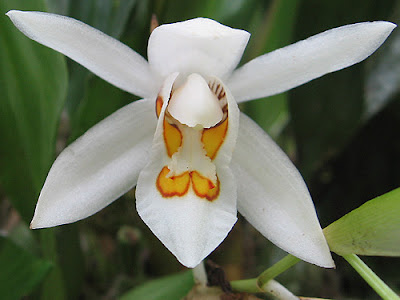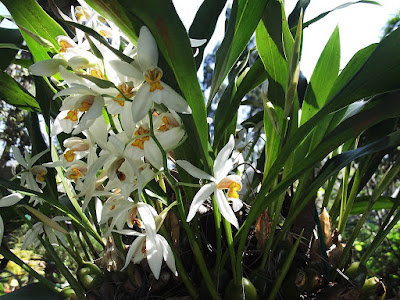Coelogyne nitida is native to Nepal through Sikkim and Bhutan, to the Khasi hills in north-east India, upper Myanmar, Yunnan province in southwestern China, Thailand and Laos. In their entire habitat, these plants are found at an altitude of 1500-2300 m...
Coelogyne nitida also called as The Shining Coelogyne, Broughtonia nitida, Coelogyne conferta, Coelogyne nitida f. candida, Coelogyne ocellata, Coelogyne ochracea, Coelogyne ochracea subsp. conferta, Coelogyne punctulata var. conferta, Cymbidium nitidum, Pleione nitida, is a species of the genus Coelogyne. This species was described by John Lindley in 1828.
IDENTIFY COELOGYNE NITIDA
Coelogyne nitida is native to Nepal through Sikkim and Bhutan, to the Khasi hills in north-east India, upper Myanmar, Yunnan province in southwestern China, Thailand and Laos. In their entire habitat, these plants are found at an altitude of 1500-2300 m. They grow on moss covered trees and rocks, in regions for which the presence of mists and drizzles is characteristic almost all year round. They are found in the subtropical zone at lower altitudes grow mainly on trees in mixed forests and areas covered with dwarf vegetation, in regions with cool, sunny and dry winter.
It is a medium sized, cool to cold growing epiphyte or sometimes lithophyte, which reaching 22-30 cm in height, with 7-10 cm long, ovoid to oblong, furrowed pseudobulbs carrying 2, narrowly elliptical-lanceolate, acute, plicate, 8 nerved, gradually narrowing below into the elongate, grooved, petiolate base, 15-20 cm long leaves.
The Shining Coelogyne blooms in the spring on an erect or pendant, basal, to 20 cm long, slightly fractiflex, terminal, 3 to 8 flowered inflorescence arising basally before a new growth emerges or terminally as a new growth arises with deciduous floral bracts and carrying simultaneously opening, fragrant flowers. The flowers with a diameter of approx. 4 cm are white with pronounced yellow dots and eye-like yellow spots on the side petals of the lip. The relatively open, sharply pointed, internal and external petals are 2.5-3.5 cm long at 0.5-0.7 cm wide. However, the outer petals are usually a little longer and wider than the inner petals.
COELOGYNE NITIDA CARE AND CULTURE
Cultural information should only be used as a guide, and should be to be adapted to suit you. Your physical location; where you grow your plants, how much time you have to devote to their care, and many other factors, will need to be taken into account. Only then can you decide on the cultural methods that best suit you and your plants.
Light:
Coelogyne nitida needs a light level of 15000-25000 lux. Strong air movement should be ensured all the time. The plants require shading from spring to autumn end, this light should be filtered and dispersed. They should not be exposed directly to the sun, especially in the middle of the day.
Temperature:
It is a plant with moderate / cold temperature requirements. In summer, the average day temperature is 18-23 ° C, night 13-14 ° C, with a daily amplitude of approx. 5 ° C. The average winter temperature is 8-9 ° C during the day and 2-3 ° C at night, with a daily amplitude of 7 ° C.
Humidity:
The Shining Coelogyne needs the humidity of 85-95% for most of the year, from late autumn to spring it drops to 75-80%.
Substrate, growing media and repotting:
Coelogyne nitida can also grow attached to pieces of tree ferns or cork, but during the hot and sunny summer days it requires high humidity and several waterings during the day. You can also grow these plants in pots or baskets, however, the best results are obtained in baskets mossy with sphagnum moss. Because the plants require extensive watering, the substrate should be permeable and breathable, but should always maintain a significant moisture.
This species should be repotted as infrequently as possible. The plants grow better if repotting is limited to absolutely necessary. The shock associated with repotting may delay flowering by up to 3 years, instead of repotting, it is better to cut off the old pseudobulbs that are already shrinking. If repotting is necessary, it should be done when the growth of new roots begins, usually immediately after flowering.
Watering:
From late spring to autumn rainfall is very abundant, but in autumn they disappear and the 3-5 month period of drought begins. During intensive growth, the Coelogyne nitida should be watered profusely, but the substrate should not be allowed to spread or become damp. When new growths reach maturity in the autumn, the amount of water should be slightly reduced.
Fertilizer:
During the active growth, the plant should be fertilized every week 1/4-1/2 of the recommended dose of fertilizer for orchids. You can use fertilizers with equal proportions of NPK during the entire growth period or use of fertilizers with reduced nitrogen content during the autumn season and increased phosphorus to improve flowering in the next season and strengthen new growth before winter.
To avoid the accumulation of mineral deposits during periods of strong fertilization, it is recommended to rinse the containers approximately every month. Rinsing is particularly important where the water is highly mineralized. To rinse the substrate, you should first water the plants normally, which will allow the salt to dissolve in the substrate. After about an hour, the substrate should be rinsed with water equal to twice the volume of the container.
Rest period:
A cool and dry resting period is necessary for healthy growth and flowering. Low temperatures (about 9-10 ° C) along with the restriction of watering for about 3 months are enough to meet the rest requirements. For about 3 months during late autumn and early winter, watering for Coelogyne nitida should be limited, but must not be allowed to stay dry for a long time. In most cases, poor watering every 3 weeks with occasional fogging will meet the requirements of the plants.















COMMENTS